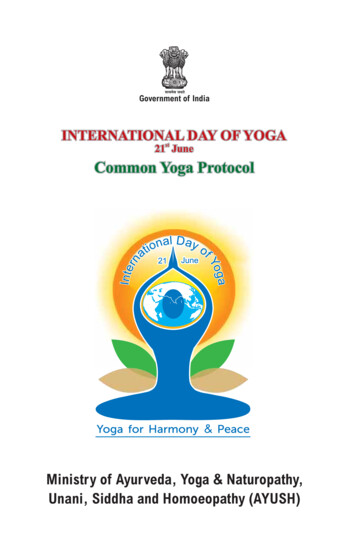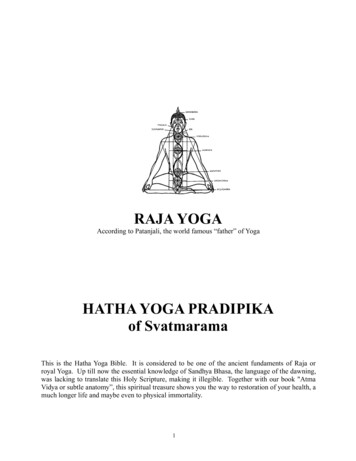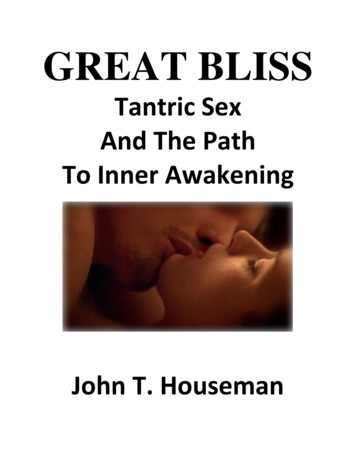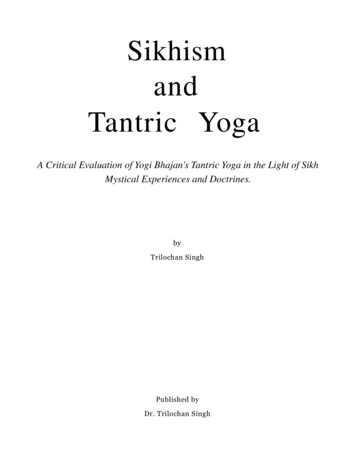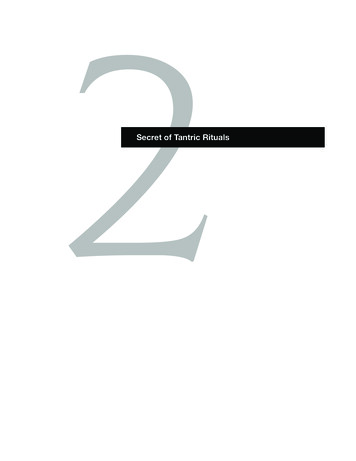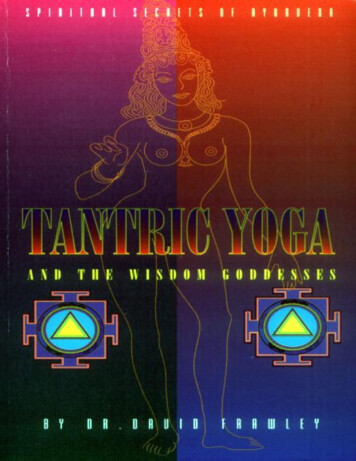
Transcription
CONTENTSForeword by Georg Feuerstein, Ph.D. 11Preface r 15I. Tantra Re-Examined 191. Traditional amd Modern Tantra 21Modem Tantra and its Misconceptions; Tantra and the New Age; Tantra and Sex; Tantra and theBody; Tantra and the Reality of the World; Tantra and Emotions; Tantra and the Use of Intoxicants;Tantra and Crazy Gurus; Tantra and the Worship of the Goddess; Tantra and Kundalini; Tantra andArt; Tantra and Science; 'fraditonal Hindu Tantra; For the Future2. Tantric Paths 36Right and Left-Handed Tantra; The Third or Direct Path3. Levels of Tantric Teaching 45The Meaning of Shakti; Tantra, Mantra and Yantra; Yantra and Mandala; Meditation Forms; Worshipand Yoga; External Methods: Ritual; Internal Methods: Yoga Practices; Direct Methods: Meditation;The Four Levels of SpeechII. The Tantric Teaching 57The Ten Wisdom Forms of the Goddess 59The Goddess as Knowledge; The Ten Wisdom Forms of the Goddess; Origin of the Ten WisdomGoddesses1. Kali: The Goddess of Yogic Transformation 64Kali and Time; Kali as Being; Kali as Nirvana; Kali as the Element of Air; Kali as the Power ofAction; Kali as Beauty; Kali and Shiva; Location in the Body; Meditation Form; Mantra; MeditationApproaches; Ramakrishna2. Tara: The Saving Word 76The Savioress; Tara as Om; Sound and Breath; Thra as Knowledge; 'Para as Speech; Tara and Gauri;Ugra Thra/Nila Sarasvati; Location in the Body; Meditation Form; Mantra; Meditation Approaches
3. nipura Sundari: The Beauty of the Three Worlds 86The Beauty of Pure Perception; The Goddess of Vedantic Knowledge; Thpura, The Three Cities;Lalita, She Who Plays; Rajarajesvari, the Supreme Ruler of the Universe; Sundari as a Young Girl;Sundari as Knowledge and Consciousness; Soma and the Moon; Location in the Body; MeditationForm; Mantra; Meditation Approaches; Ramana Maharshi & Anandamayi Ma4. Bhuvaneshvari: The Queen of the Universe 96The Goddess as Space; The Goddess of the Universe; Maya; As the Power of Love; As Peace; As theVoid; Location in the Body; Meditation Form; Mantra; Meditation Approaches5. Bhairavi: The Warrior Goddess 104Bhairavi as the Supreme Goddess of Speech; Bhairavi as Tapas; Bhairavi as the Woman Warrior;The Three Forms of Bhairavi; Bhairavi and Rudra; Location in the Body; Meditation Form; Mantra;Meditation Approaches6. Chhinnamasta: The Consciousness Beyond the Mind 112The Image of the Severed Head: Going Beyond the Mind; Prachanda Chandika; Indrani; Lightning orElectrical Force; The Power of Destruction; Chhinnamasta and Kundalini; Location in the Body;Meditation Form; Mantra; Meditation Approaches; Ganapati Muni7. Dhumavati: The Grandmother Spirit 122The Grandmother Spirit; Primordial Darkness; The Void; The Power of Suffering; Dhumavati andKali; Location in the Body; Meditation Form; Mantra; Meditation Approaches8. Bagalamukhi: The Hypnotic Power of the Goddess 130The Power of Silence; The Weapon of Brahman; The Reversal of Opposites; Location Within theBody; Meditation Form; Mantra; Yogic Approaches: Bagalamukhi as the Goddess of Yoga9. Matangi: The Utterance of the Divine Word 138Matangi as the Spoken Word; Matangi and Sarasvati; Matangi as the Guru; Matangi and Ganesha;Matangi as the Outcast; Matangi and Joy; Matangi as the Minister; Location in the Body; MeditationForm; Mantra; Meditation Approaches10. Kamalatmika: The Lotus Goddess of Delight 146The Goddess of the Lotus; Kamala and Sundari; Material and Spiritual Wealth; Kamala, Lakshmi andKali; The Last of the Ten Wisdom Goddesses; Location in the Body; Meditation Form; Mantra;Meditation Approaches
11. Relationships Between the Dasha Mahavidya 153Beneficent and Terrible Forms; Kali, Tara and SundariIII. The Practice of Tantric Yoga and Ayurveda 1571. Tantric Yoga The Science of Psycho-Physical Transformation 159The Three Bodies; Primal Matter and the Self; Brahman, the Absolute; The Five Sheaths and theSeven Levels of Existence; The Seven Chakras; The Nadis; The Five Pranas in the Subtle Body;Beyond the Astral Body2. Opening the Chakras 174Signs of Opened Chakras; Manifestations of the Subtle Sense Organs; Misinterpretations of theChakras3. Tantric and Ayurveda Science Prana, Tejas and Ojas: The Spiritual Energies of Air, Fire andWater 183I. Agni and Soma: The Key to Yogic Processes; H. Prana, Tejas and Ojas: The Spiritual Energies ofAir, Fire and Water; Mental Components of Speech (Vak) and Breath (Prana); Examining Prana,Tejas and Ojas; Tantric Deities for Prana, Tejas, and Ojas4. Tantric and Ayurvedic Secrets for the Practice of Yoga 197General Regimen for Yoga Practice; Ayurvedic Health Regimens; The Right Attitude; SpecificRegimen for the Practice of Yoga5. How to Develop Tejas: The Spiritual Energy of Fire 200Tejas and Speech; Tejas and Will; Yogic Practices; Herbs and Diet; Gems6. How to Develop Prana: The Spiritual Energy of Air 209Yogic Practices; Herbs and Diet; Gems7. How to Develop Ojas: The Spiritual Energy of Water 215Yogic Practices; Herbs and Diet; Gems: Protecting Ojas8. Integral Development of Prana, Tejas and Ojas 221Integral Practice; The Solar Yoga; Meditational and Kundalini Disorders; Drugs; AdditionalMovements of Prana, Tejas and Ojas
IV. Appendices 227The Ten Wisdom Goddesses and Buddhism 229Tara; Chhinnamasta/Vajra Yogini; General Connections Between Hinduism and BuddhismPronunciation of Sanskrit 236Glossary of Sanskrit Terms 238Glossary of Special Oriental Herbs 245Bibliography 246General Index 249Herbs and Remedies index 255
LIST OF ILLUSTRATIONSKavyakantha Ganapati Muni 5Shri Ramana Maharshi & Ganapati Muni 14Uma Parvati 37Sri Chakra/Sri Yantra 49Shiva Linga 52Kali Yantra 63Kali 65Tara Yantra 75Tara 77Inripura Sundari Yantra 85Tripura Sundari 87Bhuvaneshvari Yantra 95Bhuvaneshvari 97Bhairavi Yantra 103Bhairavi 105Chhinnamasta Yantra 111Chhinnamasta 113Dhumavati Yantra 121Dhumavati 123Bagalamukhi Yantra 129Bagalamukhi 131Matangi Yantra 137Matangi 139
Kamalatmika Yantra 145Kamalatmika 147Muladhara Chakra 164Svadhishthana Chakra 165Manipura Chakra 166Anahata Chakra 167Vishuddha Chakra 168Ajna Chakra 169Sahasra Padma Chakra 170Dakshina-Murti 175Ganesha 201David Frawley and K. Natsan 256
FOREWORD
by Georg Feuerstein, Ph.D.Tantrism has a long and illustrious history in India, Tibet, Assam, Kashmir, and Nepal. Oncewidely celebrated, it acquired during the British Raj a notoriety that led to its suppression andalmost complete disappearance in India. Today Tantrism is thriving only in the form of TibetanBuddhism (Vajrayana).One of the principal reasons for the decline of Hindu Tantrism was the inclusion of sexualpractices in its rich repertoire, which offended the sensibilities of Hindu puritans. Although thesepractices were pursued by only a small Tantric minority, in the minds of the influential Hindubrahmins Tantrism and sexuality became almost synonymous.A similar confusion exists nowadays in the West where Tantrism has been experiencing amoderate renaissance ever since the psychedelic revolution of the 1960s. Here, however, it isprecisely the sexual orientation of Tantrism that attracts Western seekers who have tired of the sexnegative attitude prevailing in the Judeo-Christian tradition. Many Western seekers think ofTantrism solely in terms of its sexual practices, and not a few who actually immerse themselves inTantric teachings do so merely for hedonistic reasons. Tantrism, however, is not about selfishpleasure but about ego-transcending bliss, and it is not about sex as such but about thetransmutation of sexual energy.Today we find ads for Tantra Yoga in a variety of publications, and those who happen to havetheir names on a New Age mailing list can expect to receive junk mail inviting them to Tantriccelebrations in idyllic settings, promising pleasure and fun. This comeback, questionable though itis in some respects, represents a significant change from the 1920s when the first Englishtranslations of Tantric scriptures (called Tantras) were published . and largely ignored.However, the recent increase in popularity has not gone hand in hand with a comparabledeepening of understanding. This is most regrettable because Tantrism is a fascinating spiritualtradition that contains a wealth of insights useful to those who seek to explore the depths of humanconsciousness. Under appropriate guidance it can even be a potent tool of self-transformation andspiritual realization.The problem is that few Western students of Tantrism go to the trouble of studying the Tantricliterature itself (whether in the original Sanskrit language or in reliable translations). They alsotend to overlook the fact that Tantrism is an initiatory tradition, that is to say, it is based on thetime-honored guru-disciple relationship. No scripture can convey the living experience that iscentral to a spiritual tradition. It is the teacher's instructions that infuse the scriptures withlifeblood. Moreover, it is the guru who in countless practical ways assists the disciple's spiritualawakening and subsequent growth.Tantrism is a powerful spiritual path, and like anything that is powerful it has its dangers.Without real guidance and a strong sense of responsibility, the Tantric practitioner is apt tosuccumb to ego-inflation and the misuse of the abilities awakened in him or her.
It is also true that few Westerners are prepared for a traditional pupilage. According to an oldadage, the teacher comes when the pupil is ready. Clearly, then, anyone interested in practicingTantrism must first study the Tantric teachings to obtain the necessary intellectual and moralfoundation for real Tantric discipline. The present work by David Frawley (Vamadeva Shastri) isideally suited to provide such a basis for further study and practice.Tantric Yoga and the Wisdom Goddesses is an excellent introduction to the essence of HinduTantrism. The author discusses all the major concepts and offers valuable corrections for manyexisting misconceptions. He also introduces the reader to the core Tantric practices of meditationand mantra recitation, focusing on the Ten Wisdom Goddesses (dasha-mahavidva).These Goddesses are personifications of the feminine aspect of the Divine. The Tantricpractitioner approaches them and seeks to obtain their grace through ritual worship and meditation.The Goddesses' respective spiritual energies then convey the practitioner (sadhaka) safely andswiftly to Self-realization. The teaching of the Ten Wisdom Goddesses is little known but ischaracteristically Tantric, and it affords Western students reliable access to the metaphysics andspiritual discipline of Tantrism.David Frawley is well known as a champion of Ayurveda (India's native medical tradition),Jyotisha (Indian astrology), and the Vedas (the earliest scriptures of Hinduism). In particular, hisinterpretations of the Vedas and his revisioning of early Indian history represent importantcontributions to a reappraisal of the spiritual wisdom originating with the seers and sages of India.In the present book, David Frawley does for Tantrism what he has already done for theancient Vedic tradition. He is a popularizer in the best sense of the word: He seeks to address asmany readers as possible, endeavoring to communicate to them deep truths faithfully but withoutthe overload of detail found in academic publications. While I do not always agree with him, Irespect and appreciate his learning, understanding, and inspiration, as well as his passionatecommitment to making India's wisdom accessible to Western seekers.Anyone who has met David Frawley knows him to be a walking encyclopedia when it comesto Hindu metaphysics and spirituality. Knowledge bubbles forth from him like a clear, refreshingspring from which pilgrims can safely quench their thirst for higher wisdom. I can heartilyrecommend this work.Georg Feuerstein, Ph.D., is the author of over twenty books, includingEncyclopedic Dictionary of Yoga, The Yoga-Sutra of Patanjali, Sacred Paths,and Wholeness or Transcendence? He is on the editorial board of theEncyclopedia of Hinduism, a contributing editor of Yoga Journal, and senioreditor of Intuition magazine.
Shri Ramana Maharshi and Ganaptai Muni
PREFACETantra has become one of the more well known and popular aspects of Eastern spirituality inthe world today. A whole modern neo-Tantra appears to be arising, with various forms in theWestern world as well as in India. Tantra appears to have a freedom and universality that themodern mind is seeking, which is creative, diverse and stimulating and therefore wide in terms ofits potential audience. Yet Tantra remains one of the least understood of the yogic teachings. Thespiritual and meditational side of Tantra has not been explained in detail or in depth, particularlyfrom the standpoint of the Hindu tradition, wherein perhaps the greatest diversity of Tantricteachings exists. Hence it is necessary that we take a new look at this important part of the Yogatradition.Tantra can perhaps best be defined as an energetic approach to the spiritual path, usingvarious techniques including mantra, ritual, Pranayama, and meditation. It contains a devotionalapproach emphasizing the worship of the Goddess and her Lord, Shiva. It contains a way ofknowledge, directing us to Self-realization and the realization of the Absolute. As such it is acomplex yet integral system for the development of consciousness which has something for allthose who are seeking the truth.This book presents the meditational and mantric side of Tantra, which is the more commonside of Tantra practiced in India. It is written from the standpoint of a practitioner and also fromone trained in Ayurveda (yogic medicine). As such, it tries to present the living spirit and practiceof Tantra, rather than just another academic view. The book is divided into three primary sections,with the fourth as an Appendix. The book attempts to present the background, theory, and practiceof Tantric Yoga.1. Part One examines the background of Tantra relative to modern culture,including Tantra in the West today, the traditional Hindu view of Tantra, and thedifferent levels of Tantric teachings relative to the traditional understanding ofTantra in India. The purpose of this section is to create a foundation for theunderstanding of Tantra in its full scope.2. Part Two presents one of the major teachings of Tantra - that of the DashaMahavidya or Ten Wisdom Forms of the Goddess. All the levels of the Goddessf r o m her symbolic forms to her higher meditational approaches aresystematically explored. This is the core section of the book.3. Part Three examines Tantric yogic practices specifically relative. toAyurveda, the traditional medicine of India. It gives detailed information aboutthe process of the development of consciousness and the practices which help tofacilitate it. This is the practical part of the book for yogic practitioners.
4. The Appendix correlates Hindu and Buddhist Tantric systems in onechapter, and includes a Sanskrit key, Sanskrit glossary, and bibliography.Kavyakantha Ganapati MuniMuch of the Tantric knowledge presented here, particularly that relative to the Ten WisdomForms of the Goddess, is based upon the work of Kavyakantha Ganapati Muni (1878-1936).Ganapati was perhaps the foremost disciple of Ramana Maharshi, whom many regard as theforemost guru and sage of modem India. In fact it was Ganapati who gave Ramana Maharshi hisname, as previously the boy sage was called Brahmana Swami. Ganapati and Ramana wereregarded as modem incarnations of Ganesh and Skanda, the two children of Shiva and Parvati. Iwas blessed to receive nearly the whole mass of Ganapati's existent works through one of his fewliving disciples, K. Natesan, now in his eighties, who is their sole living repository. Nearly allthese works are in Sanskrit, mainly in out of date editions or as copied by hand by Natesan fromGanapati's own hand written manuscripts.Ganapati Muni was a great Tantric and wrote from his own experience. He was one of thegreatest of all Sanskrit poets and understood the entire tradition, back to the oldest Vedas. Hepresented all the correlations of Tantra from outer ritual to the highest spiritual knowledge, andfrom its ancient Vedic roots. In his own life Ganapati had a unique yogic experience that indicatesthe extent of his realization. After years of intense yogic practice he experienced the opening up ofhis skull, the loosening of the suture at the top of the head. After that a light and energy radiatedfrom the top of his head. He lived in the state transcending the ordinary mind-body complex, notjust as an idea, but as a physical fact.Ramana MaharshiRamana Maharshi (1879-1950) himself is well known as a jnani or silent sage and is notusually thought of as a Tantric teacher. However, he did install a Shri Chakra, the most importantTantric symbol, at his mother's Samadhi, which became the center around which his ashram hasgrown up. Both he and Ganapati Muni empowered the Chakra and observed the regular worship ofit. When in the presence of Maharshi, Ganapati Muni was composing the concluding verses to UmaSahasram, his great Tantric work on the Goddess, Maharshi opened his eyes and said, "Have youfinished all that I have dictated?" In this regard we may consider that the Maharshi also had a placein the Tantric knowledge presented by Ganapati Muni.Contact and study with other great Hindu gurus like Anandamaya Ma and Ramakrishna, theformer the Goddess incarnate and the latter the great devotee of Kali, were also importantinspirations in the search that has produced this book.There are two notable books that mention the Ten Wisdom Forms of the Goddess. The first is
Haresh Johari's Tools for Tantra. It can be consulted for those who are looking for moreinformation on the meditation forms and yantras for the Goddesses, the latter of which are given incolor. The second is Shankarnarayanan's The Ten Great Cosmic Powers, which provides muchinformation on the inner meaning of the Goddesses. Some of this derives from Ganapati Muni, aswell as Sri Aurobindo. Shankaranarayan, like my friend and teacher M.P. Pandit, was a disciple ofKapali Shastri, who himself was the main disciple of Ganapati Muni and later joined SriAurobindo. M.P. Pandit, who passed away this year (1993) was an important source of inspirationfor my Vedic and Tantric work, and also has some notable work on Tantra on his own.Tantric Yoga and the Wisdom Goddesses is part of a series of books I have written on thegreater Vedic (Hindu) tradition. Previous volumes deal with Ayurveda, Vedic Astrology, Vedicculture and its history, translations and interpretations from the Vedas and Upanishads, and studiesin the Hindu 'Tradition. The present volume on Tantra fills in a major section of the tradition.The book was not planned but happened spontaneously as a convergence of three factors. Thefast was my long term worship of the Goddess and her consort Lord Shiva. The second, as notedabove, was my recent contact with the works of Ganapati Muni. The third factor was the growinginterest in Tantra in the West and the need to inform people of the deeper meditational tradition ofTantra, which most people are not properly aware of.Only through the grace of the Divine Mother (in her form of Rajarajeshvari or the SupremeQueen of the Universe) did the book take shape so quickly. The core of the book was written inFebruary 1992, with revisions and additions through July, and some minor alterations after thatpoint. The book is not based on any antecedent material of my own. However, a considerableamount of material originally part of the book explaining Hindu Tantra, Tantra and the Vedic andVedantic traditions, Tantra and Astrology, and Tantra and other spiritual traditions throughout theworld was not included so as to make the book simpler in its format. Perhaps I will make thisadditional material available in another form later should an interest in it arise.The main person who helped inspire this book was K. Natesan, now staying at theRamanasramam in South India, whose sole motivation has been to promote the teachings of hisgreat guru Ganapati Muni. J. Jayaraman of the Ramanasramam also deserves mention for showingme how to chant many of the great hymns to the Goddess in Sanskrit through which my Tantricstudy has proceeded. Margo Gal did excellent work on the illustrations for the book, including allthose for the Ten Wisdom forms of the Goddess, reflecting the highest traditions of South Indianart, and also produced them on a short notice. Ken Johnson was helpful with the book as usualexamining and proofing the manuscript. The Thantra Vidya Peedham of Alwaye, Kerala, providedthe illustrations for the chakras.It is my fervent wish that this book will deepen the study of Tantra today and bring a respectfor its meditational approaches. I also hope that it will help bring about an understanding of theclose relationship between Tantra, Yoga, Veda and Ayurveda, which are different aspects of thesame tradition, each inherent in the other, and perhaps the planet's most complete and integralsystem of spiritual development.
David Frawley (Vamadeva Shastri)Santa Fe, New MexicoJuly 1992
PART I
TANTRA RE-EXAMINEDThe Goddess Speaks:Before the beginning of the universe I alone existed, with nothing other thanmyself. That Self-nature is called by the names of consciousness, wisdom, and thesupreme Brahman.- Devi Gita IV.3I create the Father of the universe on the summit of the worlds. My origin iswithin the cosmic waters, in the universal sea. From there I extend to all theworlds and touch the ridge of Heaven.I blow like the wind, setting in motion all the universe. Far beyond Heavenand beyond this Earth extends my greatness.- Yak Ambhrini, Rig Veda X.125.7-8
1TRADITIONAL AND
MODERN TANTRAOh Goddess, Lord Shiva, having created the sixtyfour Tantras to confuse theentire world to become dependent upon external powers, again by your wordbrought down your Tantra, which gives self-reliance and fulfills at once all theaims of life.- Shankaracharya, Saundarya Lahari 31In this section of the book we will examine the background of Tantra to help create a suitablefoundation for approaching Tantra according to its deeper and higher practices. We will explorehow Tantra relates to current cultural backgrounds and how Tantra has been understood from atraditional Hindu perspective. We will see that much of what is popularly believed about Tantratoday is not correct, and learn about the many sides and dimensions of Tantra beyond currentstereotypes about it.MODERN TANTRA AND ITS MISCONCEPTIONSTantra is a complex tradition, interwoven with the spiritual teachings of India and beyond,going back far into ancient history. The popular understanding of Tantra in the West todayrepresents only a part of this vast system of knowledge. Tantra in the West has come to beassociated with special sexual practices, with the worship of the Goddess, with Kundalini and thechakras, with a life and body affirmative approach to the spiritual path, and with a temperamentthat is artistic and dramatic rather than ascetic and otherworldly. It is sometimes associated withall that is exotic, dramatic, or dangerous in spiritual practices. While there is some validity to thisperception, it does not comprehend all the aspects of the Tantric tradition, nor reveal its essence.We could compare the state of Tantra in the West with that of Yoga, with which it is related.Like Tantra, the physical side of Yoga is emphasized - the practice of yogic postures or asanas even though these represent a small part of classical Yoga, whose main concern is meditation. Welive in a materialistic age wherein spiritual traditions are recast or scaled down into a physicalmodel. While this can be a helpful way of introducing teachings in today's cultural setting andcertainly enriches our healing systems, it does not reveal the true scope or intention of theseteachings.TANTRA AND THE NEW AGERecent popular or New Age spirituality in America looks in many respects like a new form ofTantra, making use of both its occult and spiritual sides. New Age spirituality includes theexploration of a whole range of energetic practices via the body, senses and mind, both forachieving personal and spiritual goals, as well as a recognition of the Goddess. It appears to be anextension of Tantric openness and experimentation into the technological age.Many of the new spiritual and occult teachings of this century in the West have a strong
influence from Hinduism, Buddhism and Taoism - particularly the yogic traditions - and therebyshow an influence of Tantra, which is an important aspect of these systems. Many are based onTheosophy and Alice Bailey, who borrow directly from Hindu and Buddhist teachings, includingthe Vedas, Puranas, and Tantras. Others use Native American paths which have much in commonwith Oriental teachings like Tantra. There is similarly an interest in Shamanism, whose ritualisticside resembles Tantra. In addition is a renewed interest in the older mystic traditions of Europeand the West - Christian mysticism, alchemy and astrology, Kabbala or Sufism - which appear tohave more in common with Oriental teachings like Tantra than with their own orthodoxcounterparts. This trend includes a renewed interest in pagan European traditions, which havemany affinities culturally and historically with the Vedic and the Tantric.However, while there are many positive trends in this phenomenon, much more developmentis needed in order to make these new approaches into a serious tradition. We are still in the initialstages, exhibiting the creativity, confusion and chaos of a new birth. Not infrequently the moresuperficial, preliminary, or sensate side of these teachings are emphasized, with appeals to fantasy,self-indulgence and entertainment. The experiential and deeper spiritual side of the teachings isthereby misrepresented or missed altogether.In addition, we have a syncretic predilection and like to combine various teachings andtraditions together. This reflects the breaking down of barriers which is part of the global age thatis beginning to dawn. While such open-mindedness is helpful in expanding our horizons, it is notwithout its limitations. hying too quickly to combine spiritual teachings and traditions can be liketrying to grow oranges, apples and bananas on
Tantrism must first study the Tantric teachings to obtain the necessary intellectual and moral foundation for real Tantric discipline. The present work by David Frawley (Vamadeva Shastri) is ideally suited to provide such a basis for further study and practice. Tantric Yoga and the Wisdom Goddesses is an excellent introduction to the essence of .


